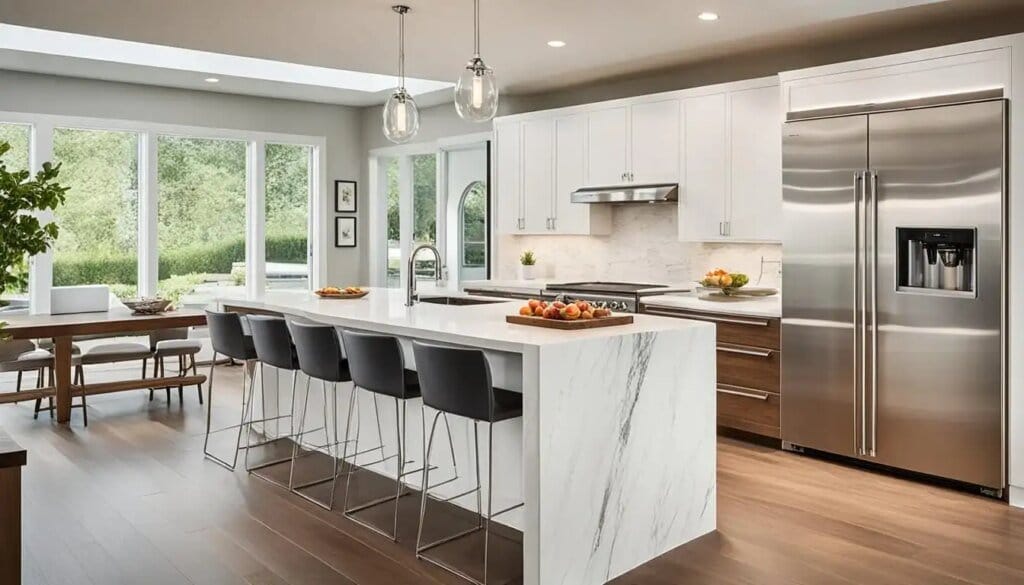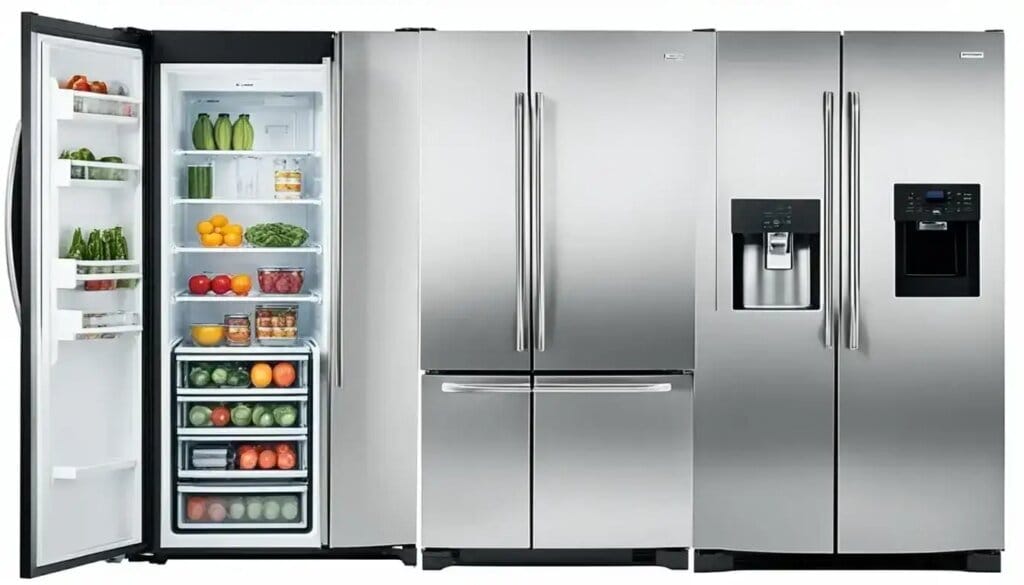Choosing between a built-in vs counter depth refrigerator becomes more than just selecting an appliance—it’s about crafting the heart of your kitchen design.
When embarking on a kitchen remodeling project, it’s essential to weigh your refrigerator options carefully. The built-in refrigerator features immerse seamlessly into your cabinetry, offering a made-to-measure look, while counter-depth units align more closely with your countertops for a unified but less customized appearance.
Let’s make the distinctions clear and helping you choose the perfect refrigerator for your home with this guide!
Key Takeaways
- Understanding the differences between built-in and counter-depth refrigerators is key for kitchen design.
- Built-in refrigerators are ideal for custom kitchen designs, integrating snugly with cabinetry.
- Counter-depth fridges align with countertops but may have doors that protrude slightly.
- Choosing the right refrigerator involves considerations of aesthetics, budget, and space.
- Awareness of the various refrigerator options available can significantly impact your kitchen’s functionality and style.
- The type of refrigerator you select can influence the overall feel and value of your kitchen remodel.

Understanding The Built-In Refrigerators
When I embark on a kitchen remodel, one of the most remarkable changes involves updating kitchen appliances, with the built-in refrigerator often becoming a focal point.
There’s an inherent luxury and sophistication that comes with built-in refrigerators, easily spotted in kitchens with a seamless design. They are carefully installed within kitchen cabinets, offering a sleek profile that contributes to a streamlined, clutter-free environment.
1. What Defines A Built-In Refrigerator
What immediately sets a built-in refrigerator apart is its design to integrate into the cabinetry.
- With panel-ready options, built-in units can be fitted with custom cabinet fronts that match the surrounding kitchen cabinets, ensuring an uninterrupted visual flow.
- Whether one opts for stainless finishes or cabinetry panels, these integrated appliances redefine what it means to have a modern kitchen.
2. Differences In Built-In Refrigerator Types
I find two main types in the realm of built-in refrigerators: overlay and integrated.
- The overlay built-in refrigerators are designed to accept custom panels but have their doors standing slightly out from the cabinet faces, often making handles visible.
- The integrated refrigerators offer a completely flush installation with cabinet fronts, allowing them to vanish into the cabinetry for a consistent and elegant look across the kitchen.
3. Pros & Cons Of Built-In Refrigerators
On the plus side, these fridges add value to your home through their upscale design and provide superior longevity compared to other models. However, the heightened cost, potential for reduced storage capacity, and complexity in installation are important considerations.
| Pros | Cons |
|---|---|
| streamlined design matching kitchen cabinetry | higher initial cost compared to other models |
| panel-ready for custom cabinet fronts | may offer less interior storage space |
| longer lifespan | more complex installation process |
| can increase home resale value | requires custom cabinetry work |
- The intricacies of integrated vs counter depth refrigerator dimensions also play a part in decision-making for kitchen upgrades.
- The built-in refrigerator often requires a precise fit within custom cabinetry, which can be a significant factor in the overall kitchen remodel plan.
- Whether the goal is to create a sleek, uniform kitchen space or to invest in kitchen appliances that offer both function and fashion, built-in refrigerators are worth considering for their blend of style and sophistication.
Built In vs Counter Depth Refrigerator: Making The Choice
The conundrum of which refrigerator is right often boils down to aesthetics and finances.
- A seamless, integrated kitchen calls for built-in models, but they can stretch the budget and might offer less packing space.
- Yet, for those who prioritize a balance between cost-efficiency and sleek design, a counter depth fridge emerges as a fitting contender.
- Understanding the trade-offs between built-in vs counter depth options is crucial for my kitchen’s functionality and overall look.
Below is a comparison that lays out the key considerations to guide me:
| Feature | Built-In Models | Counter Depth Fridge |
|---|---|---|
| Integration with Cabinetry | Yes – flush with cabinets for a custom look | Partial – doors may protrude for easy access |
| Price Point | Higher – considered a luxury appliance | More accessible – a practical choice for budget-conscious |
| Installation Complexity | More complex – often requires professional installation | Simpler – can be a DIY project |
| Storage Space | Less – due to custom fit within cabinetry | More – typically deeper to accommodate more groceries |
| Aesthetics | High-end – sleek, custom panels match cabinetry seamlessly | Modern – flush appearance but with less customization |
Ultimately, whether I opt for the chic allure of a built-in or the pragmatic, stylish convenience of a counter depth refrigerator is a personal choice that hinges on my individual needs and kitchen vision. Following a comprehensive counter depth refrigerator buying guide will ensure I make a well-informed decision for my home.
Understanding The Counter Depth Refrigerators
Let’s get into what makes these refrigerator models stand out from the standard depth options, and why the KitchenAid brand could be a top choice for your home.
1. Counter Depth Refrigerator Essentials
Counter depth refrigerators are designed to align neatly with the edge of countertops, providing a seamless look in the kitchen.
- They have a shallower body compared to standard depth refrigerators, making them suitable for smaller spaces.
- While they may protrude a few inches past the counter due to the door’s depth, they maintain a standard refrigerator height and width.
- Counter depth refrigerators offer a balance between style and practicality, ideal for those who prioritize aesthetics and space efficiency.
- These models are available in various finishes and paneling options to either stand out as a statement piece or blend in with the overall kitchen design.
- Despite their slight protrusion, counter depth refrigerators avoid the bulky appearance of standard models, contributing to a cleaner and more cohesive line in the kitchen design.
2. Benefits Of Choosing Counter Depth Refrigerators
- Cost-Effective Option: Counter depth refrigerators are generally more budget-friendly compared to built-in fridges, making them a practical choice for those looking to balance cost and style in their kitchen upgrades.
- Ease of Installation: Counter depth refrigerators are easier to install as they typically do not require the complex custom cabinetry work that built-in fridges demand. This simplicity in installation can save time and effort during the remodeling process.
- Flexibility in Layout: Due to their shallower depth, counter depth refrigerators can fit seamlessly into various kitchen layouts without the need for extensive modifications. This flexibility allows for easier integration into existing spaces.
- Aesthetically Pleasing: While not as seamless as built-in models, counter depth refrigerators still offer a modern appearance that aligns well with countertops and cabinetry. They contribute to a cohesive and visually appealing kitchen design.
- Improved Accessibility: Counter depth fridges, despite their slightly protruding doors, offer easy access to stored items. Their design ensures that items are within reach without compromising on the overall look and feel of the kitchen.
- Space Efficiency: Although counter depth refrigerators may have slightly less storage capacity compared to built-in models, their design maximizes space efficiency by aligning neatly with countertops and minimizing wasted space.
- Versatile Design Options: Counter depth refrigerators come in various finishes and paneling options, allowing homeowners to choose a model that either blends in with the overall kitchen design or stands out as a statement piece.
3. Limitations Of Counter Depth Refrigerators
- Interior Storage Space: Counter depth refrigerators may have limited interior storage space compared to built-in refrigerators due to their shallower body. This limitation can impact the capacity to store larger items or bulkier groceries effectively.
- Storage Capacity: The shallower depth of counter depth refrigerators can result in less overall storage capacity compared to built-in models. While they align neatly with countertops, the reduced depth may restrict the amount and size of items that can be stored inside.
- Door Protrusion: The doors of counter depth refrigerators may protrude slightly due to their design, affecting the overall sleekness of the kitchen layout. This slight protrusion can impact the ease of access to items inside the refrigerator, especially in tight kitchen spaces.
- Aesthetic Impact: While counter depth refrigerators offer a balance between style and practicality, they may not provide the same level of customization and seamless integration with cabinetry as built-in refrigerators. The design flexibility and high-end appearance of built-in models may outweigh the limitations of counter depth options for some homeowners.

Refrigerator Dimensions: Built-In Versus Counter Depth
Understanding how built-in vs counter depth fridge dimensions will affect their kitchen’s layout and functionality.
- Built-In Refrigerators: These come with reduced depth to seamlessly integrate with kitchen cabinetry but often extend in width and height, surpassing the standard size of traditional refrigerators. This offers a sleek and custom look, which is perfect for a high-end kitchen design.
- Counter Depth Refrigerators: Known for aligning neatly with the edge of countertops, counter depth models have a shallower body that suits smaller spaces yet may protrude a few inches past the counter due to the door’s depth. However, they maintain a standard refrigerator height and width, which aligns well with many kitchen layouts.
| Refrigerator Type | Width | Height | Depth | Notes |
|---|---|---|---|---|
| Built-In | typically 36-48 inches | 80-84 inches | 24 inches | wider and taller; fits flush with cabinetry |
| Counter Depth | typically 35-36 inches | 68-72 inches | 28-30 inches | aligns with counters; may have protruding doors |
If you’re trying to decide between counter depth vs built-in refrigerator sizes, consider not only the external dimensions but also the internal storage capacity.
- Built-ins often make up for their reduced depth with additional height, which can increase overall storage volume.
- Counter depth fridges can offer similar storage, but it’s evenly distributed, which might impact item accessibility.
Integrating Style And Efficiency In Kitchen Design
As I navigate the landscape of kitchen remodeling, every detail must contribute to a harmonious balance between style and functionality. Kitchen appliances, particularly refrigerators, play a pivotal role in achieving this equilibrium.
Sophisticated homeowners often lean towards integrated kitchen design, in which every appliance enhances the overall look without compromising on efficiency.
Creating A Cohesive Kitchen Look With Built-In Models
If we’re talking about achieving that seamless look in your kitchen, nothing does it quite like built-in models.
- These units allow for a flush fit with cabinetry, ensuring your fridge doesn’t disrupt the flow of your kitchen’s cabinet look.
- Integrated models are particularly adept at merging with your kitchen’s design to create an uninterrupted visual appeal that’s both sleek and efficient.
- Embracing the seamless integration, my kitchen remodeling plan always includes a detailed selection process for a refrigerator that stands flush with the cabinets, enhancing the kitchen aesthetics remarkably.
How Counter Depth Refrigerators Complement Kitchen Aesthetics
Counter depth refrigerator features add to the kitchen aesthetics by providing a tailored fit that stands nearly flush with cabinetry. Not quite built-in but significantly more blending than traditional models, these appliances ensure cabinetry and refrigerator fronts maintain a cleaner, more cohesive line.
Let’s break down some key aspects:
- Counter depth refrigerators are designed to align closely with the edge of countertops and cabinetry.
- Despite their slight protrusion, they maintain a seamless look in your kitchen, avoiding the bulky appearance of standard refrigerators.
- With options for various finishes and paneling, these refrigerators can either stand out as a statement piece or blend in with the overall kitchen design.
Below is a comparative overview highlighting how different refrigerator styles impact kitchen design:
| Refrigerator Style | Integration with Cabinetry | Visual Impact | Design Flexibility |
|---|---|---|---|
| Built-In Model | flush with cabinetry | seamless and streamlined | highly customizable with paneling |
| Counter Depth Model | nearly flush with slight protrusion | cohesive with slight emphasis | versatile finish options, less custom fit |
Whether it’s the impeccable flush front of a built-in model or the adaptable sophistication of a counter depth unit, the right choice enhances both kitchen aesthetics and functionality.

Comparing Installation Requirements For Refrigerators
Understanding the installation nuances between built-in and freestanding models is crucial. With a focus on built-in refrigerator installation tips and the relative ease of slotting in a counter depth refrigerator, let’s explore how both types integrate into your kitchen space, with an eye towards custom cabinet harmony and installation simplicity.
1. Installation Tips For A Built-In Refrigerator
Navigating the complexities of installing a built-in fridge can be quite the endeavor, with custom cabinet integration topping the list of considerations. To ensure a streamlined and professional look, here are key installation tips for your built-in refrigerator:
- Ensure precise measurements for a snug fit within cabinetry.
- Allow ample ventilation to prevent overheating and maintain efficiency.
- Verify that power requirements align with your kitchen’s electrical setup.
- Prepare to use custom panels for achieving a seamless aesthetic that rivals high-end kitchens.
Remember, the integration of a built-in fridge typically calls for professional help due to the precision required for custom cabinet harmony.
2. Ease Of Installation For Counter Depth Refrigerators
If you’re contemplating a counter depth refrigerator installation, anticipate a sigh of relief given the easier installation process. Perfect for a swift kitchen update, these freestanding units offer adaptability and require minimal structural overhaul to fit into your kitchen plan. Key advantages include:
- No need for custom cabinetry, as most units fit well with existing kitchen layouts.
- Straightforward plug-in setup with no special electrical modifications needed.
- Flexibility to move the freestanding refrigerator as needed, ideal for evolving kitchen designs.
- An efficient choice for both new-fridge installations and timely remodels.
While built-in units demand exacting specifications, the freestanding counter depth options provide a balance of style and convenience that can’t be overlooked.

Built-In And Counter Depth Models: Price Considerations
The distinction in cost between these two refrigerator options is significant and worth exploring.
- Built-ins harmonize with kitchen cabinetry, offering a sleek and custom-built appearance that can enhance the overall home value.
- On the flip side, counter-depth fridges provide a more budget-friendly alternative while still aligning nicely with the countertop to polish the look of a modern kitchen.
- The counter-depth fridge often strikes as the middle ground between standard models and high-end built-ins.
- Finding that sweet spot where budget aligns with desire and necessity can be challenging. Major appliances like refrigerators are central to kitchen functionality and design, so getting new appliances is not a decision to take lightly.
| Refrigerator Type | Average Cost | Integration with Cabinetry | Typical Lifespan | Potential for Discounts |
|---|---|---|---|---|
| Built-In | higher initial investment | excellent – designed for seamless integration | longer due to robust construction | less frequent but possible during brand-specific promotions |
| Counter Depth | moderate with room for savings | good – aligns well, slightly protrudes | comparable to standard models | more commonly available, especially during seasonal sales |
Bottom Line
Overall, as I wrap up this essential guide on making the right refrigerator choice during your kitchen remodel, I trust that the insights provided will illuminate the path towards the optimal appliance for your home.
Navigating between a built-in vs counter depth refrigerator invariably comes down to a harmonious balance of design, functionality, and financial prudence. Kitchen design decisions are deeply personal, with every selection echoing your individuality and your home’s character.
Understanding the subtleties of your kitchen’s layout, your storage necessities, and the complexities potentially associated with installation are critical when examining these refrigerator options.
A built-in unit seamlessly melds with the bespoke ambiance of custom cabinetry, offering a sense of luxury and cohesiveness. Its counter depth counterpart, while slightly more prominent in presence, delivers flexibility and cost-efficiency, crucial for the practical-minded homeowner.
Ensure that the decision you make reflects your personal criteria and the overarching vision for your kitchen’s functionality and aesthetic. The fridge you select should not only fit like a glove in the space it occupies but also bring you satisfaction, and convenient life.
Happy cooling!
FoodiesFridge









